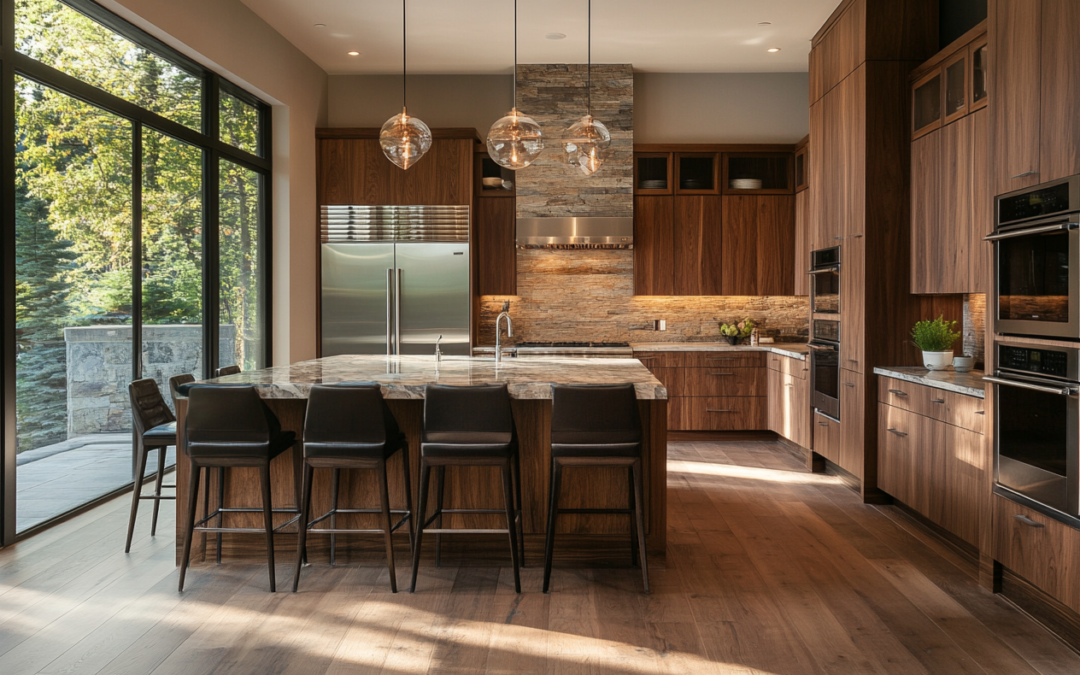A custom kitchen remodel is one of the most exciting and rewarding home improvement projects. It allows you to create a space that meets your specific tastes and needs while significantly enhancing the value of your home. However, without careful planning, the costs can quickly spiral out of control. To ensure that your kitchen remodel stays on budget and delivers the results you want, it’s important to understand all the factors that contribute to the overall cost. This guide will walk you through the key aspects of budgeting for a custom kitchen remodel, helping you manage expenses effectively.
1. Setting Your Budget Goals
Before you begin selecting materials or interviewing contractors, you need to establish a clear budget. A general rule of thumb is to allocate between 5% and 15% of your home’s value for a kitchen remodel. For example, if your home is valued at $300,000, a reasonable budget for a custom kitchen remodel would range from $15,000 to $45,000. However, this is just a guideline, and the actual budget will depend on the complexity of the project and the level of customization you desire.
Some important questions to consider when setting your budget:
• Are you planning to stay in your home for the foreseeable future, or are you remodeling to increase resale value?
• Do you have specific high-end features or materials that you’re determined to include, such as custom cabinetry or luxury appliances?
• Are there any major structural changes, such as moving walls or relocating plumbing, that will significantly increase costs?
Once you’ve answered these questions, set a firm overall budget, but make sure it’s flexible enough to accommodate unexpected expenses that may arise during the remodel.
2. Understanding Cost Factors in a Custom Kitchen Remodel
The cost of a custom kitchen remodel is influenced by a wide range of factors, many of which can vary dramatically depending on your location, the scope of the project, and your specific preferences.
Here are the key elements that will influence your overall costs:
• Size of the Kitchen: The larger the kitchen, the more materials, labor, and time will be required, which naturally increases costs. A large kitchen also offers more opportunities for layout changes and custom features, which can push the budget higher.
• Scope of the Remodel: Are you simply updating the aesthetic aspects of the kitchen (cabinets, countertops, and appliances), or are you planning a full renovation that includes changing the layout, adding an island, or expanding the kitchen footprint? Larger projects come with higher labor costs, as well as the need for additional permits and professional services.
• Custom Features: Custom cabinetry, high-end finishes, and luxury materials such as marble countertops or imported tile will increase costs. However, these items often offer greater durability and a unique design that sets your kitchen apart.
• Labor Costs: Skilled labor can be a significant portion of your budget. Hiring experienced craftsmen, electricians, plumbers, and carpenters will ensure the quality of the work, but it comes with a higher price tag.
• Geographic Location: Labor and material costs vary by region. Remodeling in a major city or high-demand area may come at a premium, whereas costs in smaller towns or rural areas might be lower.
3. Creating a Detailed Budget Breakdown
After determining your overall budget, it’s time to break it down into specific categories. A typical kitchen remodel budget might look like this:
• Cabinetry (30-40%): Cabinets are often the most expensive part of a kitchen remodel, especially if you opt for custom-built units. Semi-custom and stock cabinets can help reduce costs without sacrificing style or function.
• Countertops (10-15%): The cost of countertops varies depending on the material. While granite, marble, and quartz are popular options, more affordable alternatives like laminate or butcher block can give a similar look for less.
• Appliances (15-20%): Upgrading to energy-efficient, high-end appliances can enhance the functionality and luxury of your kitchen. However, standard models from reputable brands may offer similar performance at a lower price point.
• Flooring (5-10%): Flooring options range from budget-friendly materials like vinyl or laminate to pricier hardwood or tile. Choose a material that is durable and fits your aesthetic without exceeding your budget.
• Plumbing & Electrical (10-15%): If you’re moving plumbing or electrical outlets, this can add significantly to your labor costs. Even if you’re not relocating major components, you may still need to upgrade wiring or pipes to meet modern codes.
• Lighting (5-10%): Lighting is often an overlooked aspect of kitchen remodeling, but it plays a critical role in the overall look and function of the space. Incorporating a mix of task, ambient, and accent lighting can improve both the functionality and mood of your kitchen.
• Labor (15-25%): Depending on the complexity of the project, labor costs will vary. Hiring experienced professionals who specialize in kitchen remodels may come with higher costs but ensures the work is done right.
• Contingency Fund (10-20%): Always set aside a portion of your budget for unexpected expenses. It’s common for remodels to run into unforeseen issues like structural damage, outdated wiring, or plumbing problems that need to be addressed before moving forward.
4. Where to Splurge and Where to Save
When planning a custom kitchen remodel, it’s important to decide which aspects of the project are worth splurging on and where you can save without sacrificing quality. Here are a few areas to consider:
Splurge on:
• Custom Cabinets: Custom cabinetry can maximize storage space, improve kitchen flow, and add a premium look that off-the-shelf cabinets often can’t match.
• Countertops: High-quality countertops made from materials like quartz or granite are durable, long-lasting, and add a sophisticated touch.
• Hardware: High-quality hardware can elevate the look of even budget-friendly cabinets and is an affordable way to add a designer touch.
Save on:
• Appliances: While professional-grade appliances are attractive, most homeowners don’t need them for everyday use. You can save a significant portion of your budget by opting for mid-range appliances from reputable brands.
• Flooring: There are many affordable flooring options that mimic the look of more expensive materials. For example, luxury vinyl tile (LVT) offers the appearance of hardwood or stone at a fraction of the cost.
• Lighting Fixtures: There are plenty of stylish, affordable lighting options on the market. Spend more on quality installation and save on the fixtures themselves.
5. Comparing Contractors and Getting Accurate Quotes
To avoid budget overruns, it’s crucial to get detailed quotes from multiple contractors. When gathering quotes, make sure each contractor is bidding on the same specifications and scope of work. A quote should include everything from labor and materials to permits and timelines.
When evaluating contractors:
• Ask for references and check reviews from previous clients.
• Ensure the contractor is licensed, insured, and experienced with custom kitchen remodels.
• Make sure the contractor’s timeline aligns with your schedule, especially if you have specific deadlines.
6. Maximizing Value and Return on Investment
While the kitchen remodel is a significant financial investment, it’s also one of the highest-return renovations you can do. The key to maximizing your return on investment (ROI) is to balance your personal preferences with what will appeal to future buyers, should you decide to sell your home.
Tips to increase value:
• Choose Timeless Designs: Opt for classic colors, materials, and layouts that won’t go out of style in a few years.
• Improve Functionality: Upgrading the layout, adding more storage, and choosing energy-efficient appliances can make your kitchen more user-friendly and valuable.
• Energy-Efficient Upgrades: Installing energy-efficient windows, appliances, and lighting can reduce your utility bills and make your home more appealing to eco-conscious buyers.
7. Managing the Project Timeline and Staying on Track
Finally, it’s important to manage the project timeline to avoid delays, which can add to labor costs and create frustration. Work with your contractor to develop a realistic schedule that accounts for:
• Material lead times
• Possible delays (e.g., weather, supply chain issues)
• Inspection and permit requirements
By planning and budgeting carefully, you’ll be able to enjoy a smooth kitchen remodel that stays on budget and meets your expectations.
Conclusion
Budgeting for a custom kitchen remodel involves understanding various cost factors, making smart decisions about where to allocate funds, and planning for contingencies. By setting a realistic budget, breaking down expenses, and carefully managing the project, you can achieve the kitchen of your dreams while keeping costs under control. Keep these tips in mind, and you’ll be well on your way to enjoying a new, beautiful, and functional kitchen.
Contact Southern Stars for your next custom kitchen renovation and experience the exquisite craftsmanship and personalized touch we bring to each custom kitchen and woodwork project we undertake.

